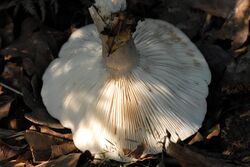Biology:Lactarius pallidus
| Lactarius pallidus | |
|---|---|

| |
| Scientific classification | |
| Domain: | Eukaryota |
| Kingdom: | Fungi |
| Division: | Basidiomycota |
| Class: | Agaricomycetes |
| Order: | Russulales |
| Family: | Russulaceae |
| Genus: | Lactarius |
| Species: | L. pallidus
|
| Binomial name | |
| Lactarius pallidus Pers. (1797)[1]
| |
| Lactarius pallidus | |
|---|---|
| Mycological characteristics | |
| gills on hymenium | |
| cap is convex or depressed | |
| hymenium is decurrent | |
| stipe is bare | |
| spore print is ochre | |
| ecology is mycorrhizal | |
| edibility: edible | |
Lactarius pallidus, the pale milkcap, is an edible mushroom of the genus Lactarius. It is pale in colour, and found on the floor in beech or birch woodland. It's smooth cap features a particularly thick layer of flesh and often has an incurved margin. Though generally considered edible, it is not recommended to be eaten raw. It is common in Europe, and less common in North America and Australasia.
Taxonomy
Lactarius pallidus was classified as a member of Lactarius by Swedish mycologist Elias Magnus Fries. It was first described by Christian Hendrik Persoon,[2] who named it Agaricus pallidus[3] in his 1797 book Tentamen dispositionis methodicae Fungorum.[4] It is known in English by its common name, the pale milkcap.[5]
Description
Lactarius pallidus has a cap of 4 to 10 centimetres (1.6 to 3.9 in) across. In shape, it is initially a flattened convex, developing a funnel-shaped depression with age. It is pale buff in colour, sometimes dull but often with a rosy tint. It can also be a pale brown or pale flesh colour. The cap is smooth, firm, and sticky, and has a thick layer of white to buff flesh. The margin is incurved on younger specimens.[2] The pale colour, incurved margin, and smooth cap are its most distinguishing features.[6] The stem is 3 to 8 centimetres (1.2 to 3.1 in) long, by 6 to 28 millimetres (0.24 to 1.10 in) thick. In shape, the stem is cylindrical or slightly narrowed at the base, and is concolorous with the cap or whitish. The moderately decurrent, crowded gills are pale rosy buff to yellowish buff, and leak white milk. The spores are elliptic, with ridges of varying thickness running across them, forming few cross-connections. They typically measure 8 to 10 by 6 to 7 micrometres. The spores leave a spore print that is pale ochre with a slight salmon tinge.[2]
Lactarius pallidus is similar in appearance to L. affinis, but is differentiated by the fact that the former lacks the peppery taste of the latter.[7]
Edibility
Though generally considered edible,[8] especially after cooking,[2] L. pallidus has been described by some mycologists as inedible.[6] The milk has a mild to moderately hot taste.[2]
Distribution and habitat
Lactarius pallidus is typically found growing mycorrhizally under beech, but can also be found under birch.[6] It is typically half-buried among leaf litter.[6] It can sometimes be found in large groups,[6] and occurs throughout summer and autumn.[2] It can be found commonly in Europe but is much rarer in North America.[7] It can also be found in Australia .[4]
See also
References
- ↑ Index Fungorum
- ↑ 2.0 2.1 2.2 2.3 2.4 2.5 Phillips, Roger (1981). Mushrooms and Other Fungi of Great Britain and Europe. London: Pan Books. p. 83. ISBN 0-330-26441-9.
- ↑ Farlow, W. G. (2007). Bibliographical Index of North American Fungi - Vol I - Abrothallus to Badhamia. Read Books. p. 143. ISBN 978-1-4067-2125-6. https://books.google.com/books?id=MPxUbxv8oCEC&q=%22Lactarius+pallidus%22&pg=PA143.
- ↑ 4.0 4.1 May, Tom. "Lactarius pallidus". Interactive Catalogue of Australian Fungi. Royal Botanic Gardens, Melbourne and Australian Biological Resources Study. http://www.rbg.vic.gov.au/dbpages/fungi/cat/details.php3?id=3397. [|permanent dead link|dead link}}]
- ↑ Phillips, Roger. "Lactarius pallidus". RogersMushrooms. http://www.rogersmushrooms.com/gallery/DisplayBlock~bid~6291~gid~.asp.
- ↑ 6.0 6.1 6.2 6.3 6.4 Pegler, David N. (1983). Mushrooms and Toadstools. London: Mitchell Beazley Publishing. p. 115. ISBN 0-85533-500-9.
- ↑ 7.0 7.1 McKnight, Vera B.; Peterson, Roger Tory (1998). A Field Guide to Mushrooms, North America. Houghton Mifflin Harcourt. p. 326. ISBN 978-0-395-91090-0. https://books.google.com/books?id=kSdA3V7Z9WcC&q=%22Lactarius+pallidus%22&pg=RA1-PA326.
- ↑ Cooke, M. C. (2007). British Edible Fungi. Read Books. p. 230. ISBN 978-1-4067-5608-1. https://books.google.com/books?id=lOrahbcWdKAC&q=%22Lactarius+pallidus%22&pg=PA230.
Wikidata ☰ Q1393910 entry
 |


